“I have a British background and I have always had tea and something sweet. First time I tried this clotted cream I almost ate the entire jar by itself, it is that good!” ~Kim

If you’ve never had a classic English afternoon tea with scones and clotted cream, you’re missing out!
Last week I was treated by the historic Biltmore Hotel in downtown Los Angeles to their classic English afternoon tea. If you’ve never had a classic afternoon tea, you need to experience it. The highlight of any afternoon tea, besides the tea, is the array of tiny treats that comes with it, and I always zero right in on the scones and clotted cream. (That’s them on level two of our 3 tiered tea tray.)

What is Clotted cream?
If you’ve never had it, clotted cream is a very thick rich spreadable form of heavy cream that was first invented ages ago by some very smart British farmers. Traditionally cream heated until it thickens and develops a slightly nutty flavor. Clotted cream has a high fat content (around 55-65%) and a dense texture. It’s not like whipped cream, or cream cheese, it’s not like butter…it has a unique decadent consistency and a wonderful soft flavor. It’s quite thick and spreadable, and when you slather it on a freshly baked scone there is no better thing in the world.
The little pot of clotted cream that we got at the Biltmore had me craving more, and happily I made the most astounding discovery…you can actually make clotted cream at home in your own kitchen. No more tracking it down in specialty stores and paying big bucks for the imported stuff. My homemade clotted cream was actually way better (and a whole lot fresher) than the British stuff I usually buy.

What does clotted cream taste like?
Clotted cream has a rich, creamy taste with a slightly nutty ‘cooked’ flavor. It’s luxurious and indulgent, with a dense, velvety texture that is thicker and creamier than regular whipped cream. Clotted cream is also slightly sweet, but not as sweet as whipped cream or frosting, with a delicate flavor that pairs well with desserts, fruit, and scones. The crust on top of the clotted cream adds a slightly caramelized and nutty flavor, which many people find particularly delicious. The mouthfeel of clotted cream is a key part of its charm, and is like nothing else you’ve ever had!
what you’ll need
- heavy or whipping cream that has not been ultra-pasteurized
- This is cream that has been pasteurized, but not ultra-pasteurized. Ultra-pasteurized cream is cream that has been heated to a higher temperature than regular pasteurized cream to extend its shelf life.

How to make clotted cream
This is an amazing process, I hardly had to do anything, and I end up with a ton of the richest, silkiest clotted cream I’ve ever had.
- I used 2 pints of (non-ultra-pasteurized) heavy cream.
- I poured them into a baking dish, and left it overnight in a 180F oven (the lowest my oven will go.)
- In the morning I let it cool and then refrigerated it for the rest of the day.
- Then I scooped it into jars, which was a little sloppy at first, and put them back in the refrigerator. Any little bit of liquid gets absorbed right into the clotted cream after you put it in the jars, and by the next morning when I had it with my scones, it was absolutely to die for.
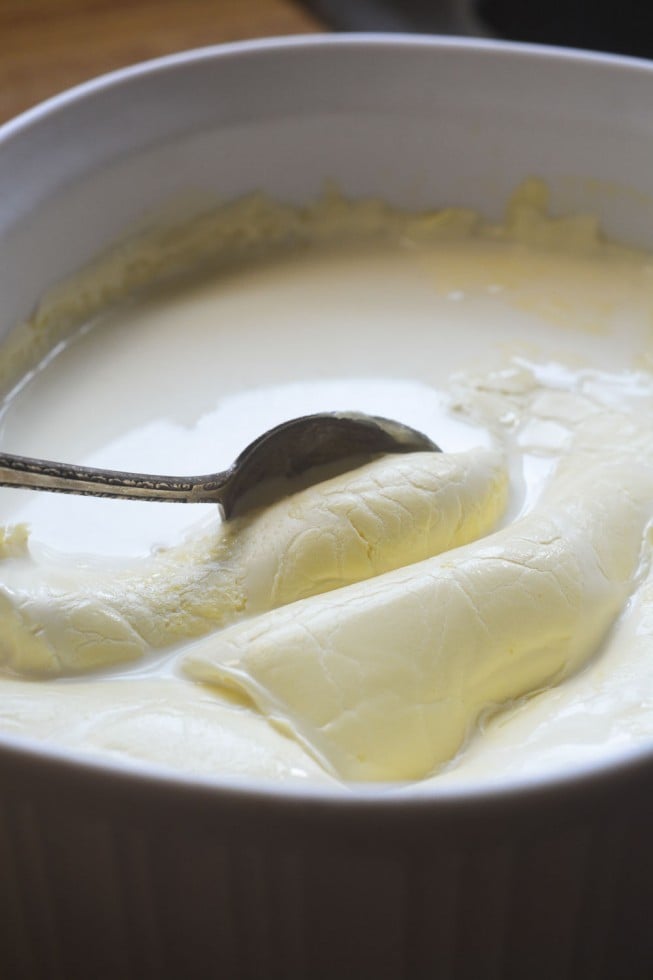
How long does clotted cream last?
Homemade clotted cream can last for up to 3-4 days when stored properly in the refrigerator. To extend its shelf life, it’s important to keep it in an airtight container and store it in the coldest part of the refrigerator, such as the back of the bottom shelf.
It’s important to note that clotted cream does not have any preservatives, so it should be consumed as soon as possible for the best flavor and texture. If you notice any changes in color, texture, or odor, discard the clotted cream immediately as it may have spoiled.
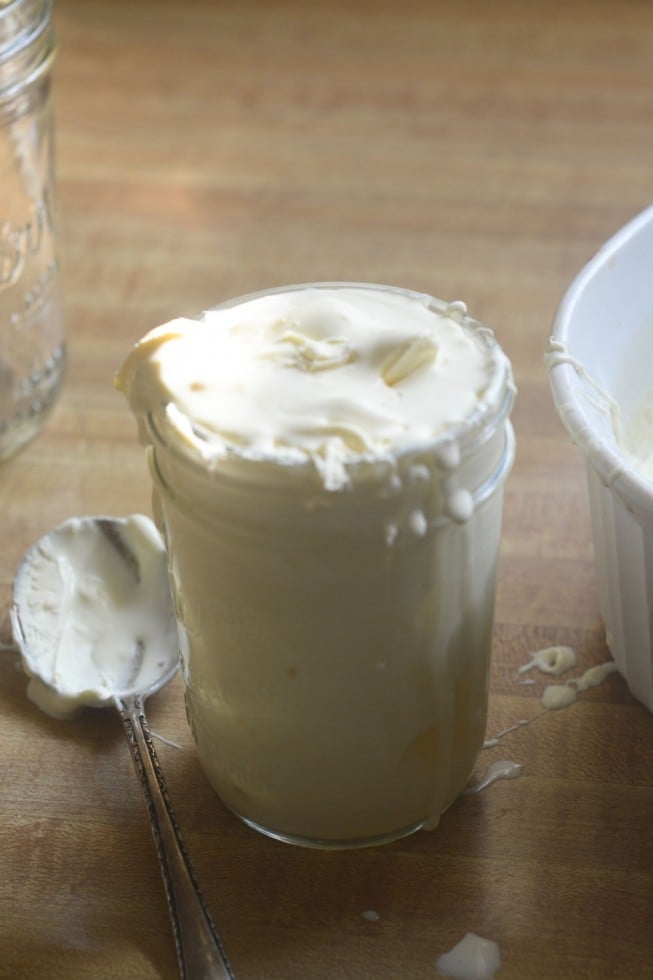
What to do with the leftover whey from making clotted cream
The leftover whey from making clotted cream can be used in a variety of ways:
- Adding it to smoothies or protein shakes for a boost of protein and nutrients.
- Using it as a substitute for milk or water in baking recipes such as bread, muffins, and pancakes.
- Using it as a marinade for meat or fish to tenderize and add flavor.
- Adding it to soups or stews for added richness and flavor.
- Using it as a liquid base for making homemade ricotta cheese or other soft cheeses.
- Feeding it to pets, as it is a good source of protein and nutrients for animals.
Note: It’s important to keep in mind that the leftover whey should be used or stored promptly to avoid spoilage. It can be stored in the refrigerator for up to a week or frozen for longer storage.
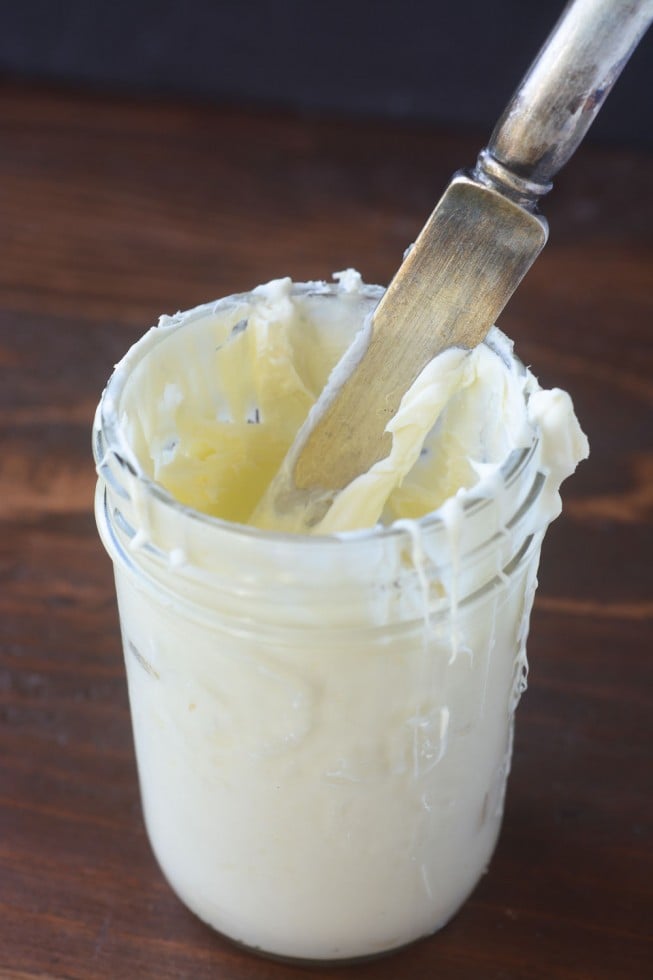
I can’t say enough good things about this project, the results far exceeded my expectations and it was absurdly easy. The only catch is that you can’t use ultra-pasteurized cream, which is cream that’s been processed for a longer shelf life. Many stores only sell ultra-pasteurized cream, so you have to search a bit for regular cream. I found mine at Whole Foods. Just read the labels… if it doesn’t say ultra-pasteurized on the label, you’re good to go.
can you make clotted cream with ultra-pasteurized cream?
Some readers in the comments below have had success with ultra-pasteurized cream. It is possible to make clotted cream from ultra-pasteurized cream, but it may be more difficult to achieve the desired texture and flavor. Ultra-pasteurization is a process that heats the cream to a higher temperature than regular pasteurization, which extends its shelf life but can also alter the proteins and enzymes in the cream. This can make it more difficult for the cream to form clots, which are necessary for making clotted cream.

What to eat with your homemade clotted cream
You will definitely want to make scones to go with your homemade clotted cream. I have lots of recipes for scones on the blog, but a simple one to start with is my Classic Cream Scones Recipe.
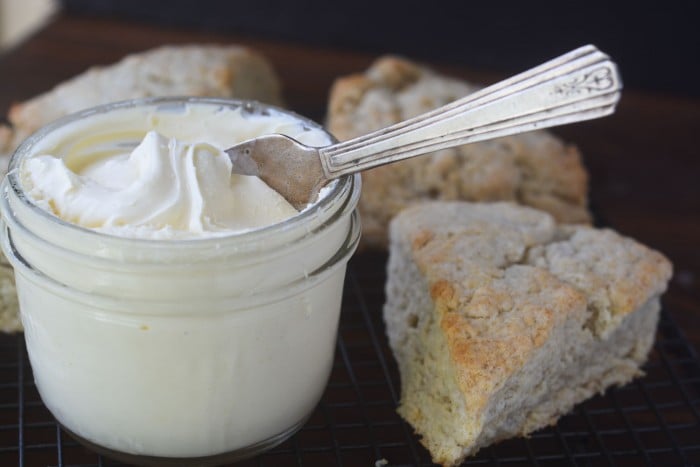
Tips for making clotted cream
- Make sure your cream is not ‘ultra pasteurized’, you will need to find regular pasteurized cream at a Whole Foods or other similar store. Ultra pasteurized cream has been treated in a way that prevents it from ‘clotting’.
- An oven thermometer is an essential kitchen tool, and really comes in handy for this project. If your oven is too cool or too hot your homemade clotted cream will not ‘clot’. Set your oven to 180F and then check the thermometer. You can adjust up or down as necessary.
- If your oven does not go down as low as 180F you can try one of my other methods for making clotted cream:

Homemade Clotted Cream
Video
Equipment
- a heavy casserole dish
Ingredients
- 2 pints heavy cream or whipping cream (double cream in the UK), avoid ultra-pasteurized cream for best results.
Instructions
- set your oven to 180F
- Pour the cream into the casserole dish. It should come up about 1-3 inches on the side.
- Set the dish, uncovered, in the oven and leave undisturbed for 12 hours. Be sure to leave the oven on the whole time. I do this overnight.
- Remove the dish from the oven and set to cool. Then cover and refrigerate. Note: the cream may seem thin at this point, but is going to thicken considerably overnight.
- The next morning scoop the thickened cream into a jar or jars, and cover and put back in the refrigerator. You can use the leftover cream for baking..
- Spread the clotted cream on freshly baked scones.
Nutrition


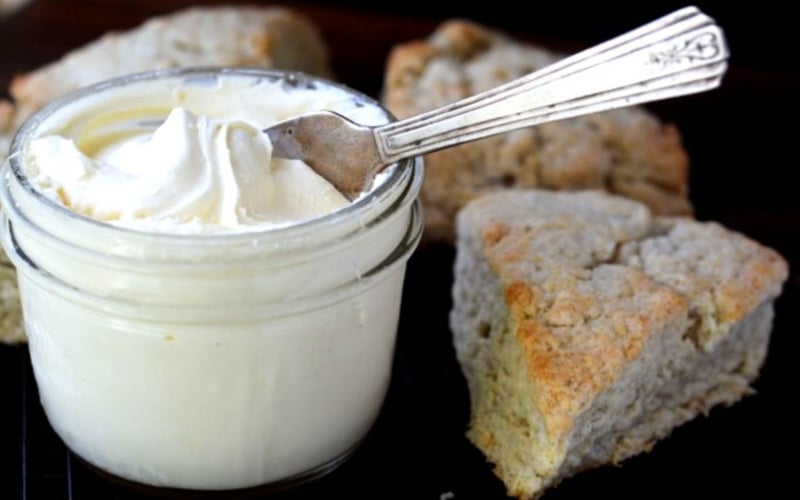




















I didn’t read through all of the comments as there were many, so I’d like to know what size casserole dish to use.
The cream should be about 2 inches deep in your dish, Patricia, and mine was an oval 1.5 qt casserole, about 91/2 inches long. It’s THIS ONE.
I desperately want to try this recipe, but in Australia all our heavy creams contain thickener (gelatin, etc) – would you know if this will still work?
I can’t say for sure, Jordan, you might just have to experiment. Please let us know what happens!
That’s not correct . The 600ml tub stuff usually does , but the 1 litre Tetrapak pack type without additives are OK .
I had a great British imported brand that I used to put in gift baskets. It’s particularly yummy used with lemon curd on scones. Also fantastic straight from the jar on a spoon.
Here are several tips for making better clotted cream.
1) Use really good cream. Taste cream before you start. If it doesn’t taste great, it won’t taste great as clotted cream.
2) The problem that most people describe in the comments is due to the temperature fluctuations in the oven. You see, when you set an oven to 180, the temperature doesn’t stay at just 180. The way an oven works is that the heat turns on for a while, then when the temperature is hot enough in the oven, then the element turns off until the temperature falls below some level. It’s just like the furnace in your house doesn’t run all the time — it turns on and off. In a new oven the temperature might cycle from 178 to 182. In an older oven, the temperature might fluctuate from 180 to 200. In a badly calibrated oven, the temperature might vary from 200 to 220, even though you’ve got it set for 180. At the very least you should put a cookie sheet beneath the pan in which you cook the cream. This will help some, but the very best solution is to use a water bath. That means that you use a pan somewhat larger than the pan you are cooking the cream in and you put some hot water in that pan, then you put your pan of cream in that pan and put the whole works into the oven. This way the temperature fluctuations will be very minor in the cream itself.
3) The pan with the cream should be covered with foil.
4) When this is made in England, it’s made with double cream. In the US you will not find double cream. That means that you will have even more liquid that is not part of the finished product.
5) What I have found that works the best in separating the liquid from the clotted cream is to remove the pan with the clotted cream and liquid from the refrigerator and then pierce the crust with a spoon. Just make a hole that goes down to the liquid layer. Now very slowly pour off the liquid to minimize mixing the liquid and the clotted cream. Keep pouring off the liquid until the part that you see draining out starts to look like thick cream. At that point all that should be left in the pan is the clotted cream, and some thicker liquid that is like thick cream. You can stir that together, or you drain off the thicker liquid into a separate container and use that like cream.
I made clotted cream a couple of days ago and it came out wonderful. There were a couple of differences in the method I used, which I found on another food blog. First, it said to cover the casserole dish, which I did. Then it said to use 170 to 180 degrees, which my oven goes down to 170 so that’s what I used. Otherwise, no differences. It came out wonderful. I used whipping cream from Snowville Creamery in Pomeroy, Ohio which I bought at Earth Fare in Rocky River, Ohio.
Snowville Creamery products are SO good! Thank you for the tip, I am going to try this recipe with the Snowville whipping cream.
Hi you may have already addresses this, but I couldn’t find the answer. How long can the clotted cream sit in the refrigerator before going bad?
The recipe I used said it needs to be used “In a few days.”
We’ve kept ours for several weeks. It’s a bit like milk that goes bad. When it happens you’ll know it. Be sure to use a very clean jar to store it of course.
Hi, I have never had clotted cream before. I was just in the UK for a couple weeks recently and I didn’t get a chance to try some. I just made scones and I wanted to make clotted cream to go with them. This recipie looked great so I decided to try it. I got some cream at the store yesturday. Turns out I got the wrong cream and had to return it and go to whole food to by the right one. I put it in a big glass dish, set my gas oven to 180f, and stuck it in there for 12 hrs overnight. It is currently cooling on my stove. I noticed that the top is golden brown, is that normal? If it’s not I’d like to know how to change that. Thanks for your time.
I followed the directions completely. And I ended up with it brown and tough on the top and completely liquid on the bottom.
Your cream needs to be 1.5 to 2 inches deep in the dish. Make sure the cream you buy does not hve the word ‘ULTRA” anywhere on the package 🙂
thanks Martha 🙂
I made clotted cream yesterday and did everything as instructed, and the consistency is perfect, but the flavor seems WAY too salty. I used reg pasteurized heavy cream from Smith Brothers and added nothing. I just went to London a few weeks ago and the clotted cream I had was perfect creaminess, not this. What do you suggest?
You say the consistency was perfect, but the flavor salty, so all I can think of is that your cream was salty ~ strange!
What is your recommended brand? Can I get it in the Seattle area?
I live in Seattle and I’ve found the cream that comes in the glass bottles in stores like PCC or Central Market/Ballard Market/etc. works the best. I think the brand is Twin Brook Creamery. You’ll pay a deposit for the glass bottle but get it back when you return it to any store that carries the brand. It really makes a fantastic clotted cream though.
The best dairy farm. Their products are great. I used to buy at regular store in Olympia.
Cows feed on different grasses which gives a different taste to the milk and presumably the creAm. I had heard of a farm in France next to the sea which has a salty tasting milk and meat from their cows. Maybe that is the source of the salty taste;)
Hello, I have been trying to attempt to make clotted cream. Before I read your blog, I purchased Ultra Pasteurized heavy cream. That was my #1 mistake. You are right, big mistake. I don’t have a indicator on my oven of 180 degrees, my oven starts at 200. So I Iowered it to where I thought 180 might be. That was my #2 mistake, I need to get an oven thermometer for the correct oven temperature. I put the cream in a shallow pan and it sat about an inch and a half, so I was pleased with that. I kept it in the oven for 12 hours. What I did get was all golden brown on top with very little clotted cream. It was mostly still all liquid, even after I let it set to room temperature and then placed it in the refrigerator over night. I was so disappointed. So I am going to give this another try.
Since my disaster I have read your blog and feel that I can accomplish this using the right cream and that the right tools.
After spending 3 weeks in the UK and Ireland I came home bound and determined to make clotted cream.
I had tea in so many shops I lost count. I love scones with clotted cream so I won’t give up. I’ll post my progress. Thank you!
I feel your pain Susan ~ I too spent time in the UK and developed a craving for this stuff. Keep me posted on your progress, and don’t forget the importance of knowing exactly what temp your oven is actually at ~ so be sure to get that thermometer. Good luck!
Help? I made this and the consistency turned out about right, but the flavor was way off. Tastes kind of spoiled maybe? I can’t put my finger on it, but it’s not good. I followed the directions. Chilled in the fridge, covered, for probably 8 hours before I scooped it into a jar. It looks right, and reading through the comments, I couldn’t figure out the issue. Any ideas??
Are you sure your cream was fresh to start with? That’s all I can think of, unless it was over cooked, but you say the consistency was right…